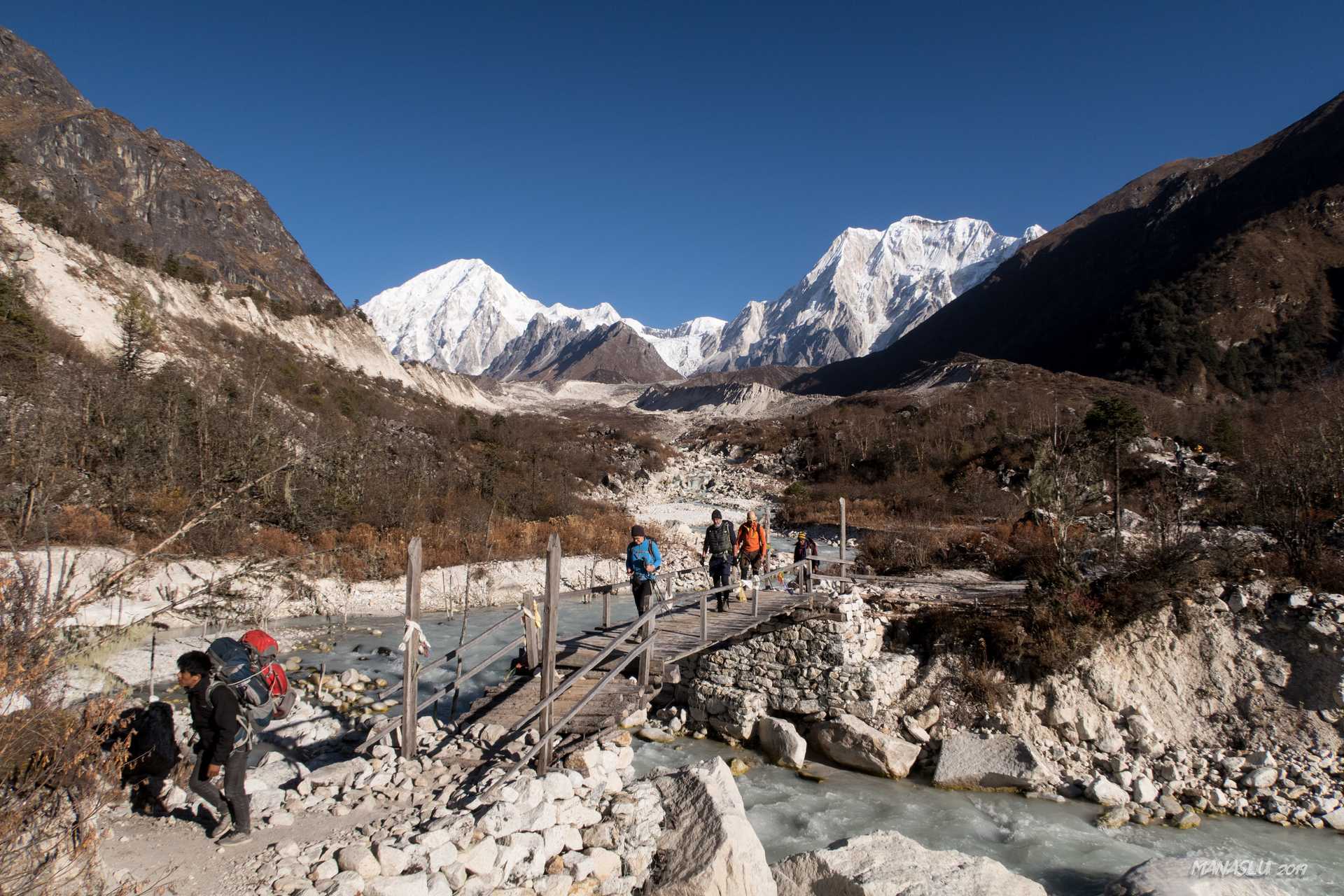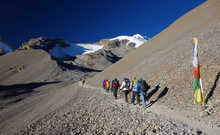The Manaslu Circuit
- Kandoo Trekking

Contact
our UK team

All trekkers need to organise their own flights to Kathmandu International Airport (KTM). From Kathmandu Airport we will arrange a private transfer to your hotel. That night you will meet your local Kandoo representative and have a full pre-trek briefing.
The journey to Arughat Bazaar starts down the main Pokhara Highway before taking a turn down a rough road. It takes approximately 6 hours to drive to Arughat, which is a large prosperous trading town.
On our first day on the trail we head north, following the Budhi Gandaki. In this low country we are trekking through rice paddies and rural villages. After climbing briefly to Kyoropani, we descend once again to the river, where it meets the Sundi Khola, and our village for the night.
We cross a bridge and climb up onto a ridge above the rapids of the Budhi Gandaki. The trail continues, climbing over a big rock and crossing a log bridge, before it eventually descends back down to the banks of the Budhi Gandaki. We trek up again on a steep rocky trail clinging to the side of a cliff, then up and around to the Gurung village of Labishe (880m) and beyond to Machha Khola.
We cross the Machha Khola river and head upstream to the tiny village of Khola Bensi and the hot springs at Tatopani. The valley becomes steeper and the route then switches to the left bank by way of a suspension bridge. The trail is quite exposed and challenging in places. After a short section of forest path we reach the single teahouse at Doan. Beyond this steep section, the route is much flatter and we will finally cross the river on a suspension bridge, and then climb on a high path to the fields of Jagat.
After descending a long series of stone steps to the river, we climb a terraced hill to Saguleri, from where we can see Singri Himal, 7187m. Our route continues upstream, through a gorge section with towering walls. We cross the river three more times in the next two hours to avoid difficult valley sides and then climb up over a further steep spur to reach the village of Deng.
As we leave Deng the valley is still steep-sided. We pass the village of Lama, and start to see Mani stones (prayers etched onto wayside rocks), a sign that we are entering a Buddhist region. After about four hours we reach the village of Ghap in the Tibetan area. As we gain altitude we move into alpine territory with great mountain views. There are more Mani stone walls and three more crossings of the Buri Gandaki on our route to Namrung.
Above Namrung the valley opens out and there are extensive pastures. Climbing gently now, and crossing a large stream flowing down from the Lidanda Glaciers, we reach the Tibetan village of Sho, and get our first views of Manaslu North and then of Manaslu Main. As we continue we come to Lho, a large village at 3150 metres where there is a lovely little monastery and numerous chortens and Manis, before arriving at Shyala.
Leaving Shyala we follow the right bank of the river, with views of Peak 29 ahead. As we continue on the main trail, we reach the fields of Samagaon.
We continue to follow the Budhi Gandaki surrounded by spectacular mountains on all sides. Manaslu is particularly impressive and we take a detour off the main path to visit Manaslu Base Camp. From here we drop back down to re-join the main route and descend to Samdo for the night.
Today we hike along the ever shrinking Budhi Gandaki river with towering mountains around us. We will find a stream that runs through Gya La, the gateway to Tibet and the remains of what used to be a trading hub. Finally we reach Larky Phedi and one of the best lodges we will have stayed in for many days!
Not long after leaving Larkya Phedi we reach the northern face of the Larkya Glacier and climb steadily to the Larkya La pass, from where there are stunning views of Cho Danda, Annapurna II and Larkya Peak. We will then walk down to Tanbuche and from there down to Bim Thang.
The trail descends into pine and rhododendron forest before following the Dudh Khola river. After we reach Karche, we make a steep climb onto a ridge, before descending again to the river bank at Goa. We continue through fields to Tilje, a large Gurung village.
Another day spent trekking the lowlands through mixed forest and paddy fields. After Dharapani, we join the Annapurna Circuit and follow this classic trek in reverse through the Marshyangdi valley to Jagat.
An easy morning's walk brings us to Besisahar before our final drive to Kathmandu which takes about 7 hours. You stay overnight in a hotel in Kathmandu.
We will collect you from your hotel and transfer you to Kathmandu Airport for your departing flight.
In Kathmandu, if you choose to eat outside your hotel,
use your common sense when selecting where and what to eat, drink bottled water
and avoid ice in drinks.
The
room prices at the teahouses are based on you taking your meals within the
teahouse - they offer discounted room pricing on the expectation that they will
receive income from food. This is standard policy at all teahouses. You
therefore cannot eat outside the teahouse, and you definitely cannot bring your
own food into the teahouse.
Your
full day by day itinerary shows what is included in terms of hotel
accommodation and meal basis. All of our pre- and post-trek accommodation is
based in Kathmandu. Where your hotel basis is B&B, you can usually purchase
snacks or meals at the hotel, which can be paid in Nepali Rupees or US Dollars. Check in time will be between 12:00 and
2:00 pm, depending on the hotel. If you arrive on an early flight into
Kathmandu, you may have to wait until this time for your room to be available.
Similarly, if you return at the end of your trek on an early flight from Pokhara,
you will not be able to check into your room straight away.
The general standard of driving
throughout Nepal is poor and badly regulated. Roads in Kathmandu are very
congested, many drivers are not properly licensed and vehicles are poorly
maintained. During the monsoon season (June to September) many roads outside
the Kathmandu valley are prone to landslides and may become impassable.
We insist on using a high standard of
vehicle and driver for all of our transfers. In Nepal it is not a legal
requirement to have seatbelts fitted in the back of vehicles, and while we try
to use vehicles that do have rear seatbelts fitted, this cannot always be
guaranteed. If you are unhappy about any aspect of the vehicle or the standard
of driving, please speak to the driver or our local office immediately.
Duffel bags
You will be provided with a large duffel bag at the pre-trek briefing that will be yours to use for the duration of your trek. Your equipment will then need to be transferred into this bag. If you are travelling with a duffel bag then it is up to you which bag you choose to use for the trek, if you are travelling with a suitcase then this will need to be left at the pre-trek hotel and collected upon your return as our porters need the bags they carry to be flexible.
The porters can carry up to 15kg in
the main equipment bag, so there is scope for
your bag to be slightly heavier while you are on the trek. However, you may
need to move items into your daysack for the flight out of Jomsom.
If you are relying on a credit or debit card for emergency funds, make sure you tell your card issuer that you will be using it abroad, or you may find that it won't work when you really need it.
We
realise that tipping may not be a common practice in all countries but for
Nepal it is a standard practice that all operators support. The decision on how
much to tip should be determined by how well the team served you while you were
on the trek. Tips are always discretionary and if you are not happy with the
service you have received you do not have to pay tips. Tips can be made in US
dollars or Nepali Rupees. It is very important that US bills be new (less than 10 years old), crisp and untorn.
We
are members of the Trekking Agencies Association of Nepal and the Nepal
Mountaineering Association, and follow their guidelines when recommending tip
levels for guides and porters. We would suggest you budget $125-$175 per
trekker for your tip contribution.
We
say goodbye to our porters in Jomsom before we return to Kathmandu. Any tips
that you wish to give to the porters will need to be carried on the trek with
you.
Duffel bags
You will be provided with a large duffel bag at the pre-trek briefing that will be yours to use for the duration of your trek. Your equipment will then need to be transferred into this bag. If you are travelling with a duffel bag then it is up to you which bag you choose to use for the trek, if you are travelling with a suitcase then this will need to be left at the pre-trek hotel and collected upon your return as our porters need the bags they carry to be flexible.
We
do not have other gear available for rental but there are many places
offering gear for rental in Kathmandu and we can recommend a number of places
for you. The quality of rental gear is very variable and it is your
responsibility to check carefully the condition of any item you rent. We
accept no responsibility for the quality of equipment hired. An indication of
the likely rental costs is below.
Most
of the rental shops close around 8pm, so if you are arriving on a late flight
the day before the trek starts there will not be an opportunity for you to
visit a rental store. If you are planning on renting equipment, you need to
make sure you have allowed sufficient time at the beginning of your trip.
All
rental equipment is included in your overall trekking bag weight, so make
sure you have allowed for this when packing your bag at home. A sleeping bag
will weigh around 2kg.
UPPER
BODY
LEGS
OTHER
ACCESSORIES
Want to ask us a question or book a private trip? Don't hesitate to contact us!
Contact us